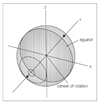Abstract
The measurement of eye movements in three dimensions is an important tool to investigate the human oculomotor system. When compared with the conventional electro-nystagmography (ENG) and scleral search coil system (SSCS), the video-oculography (VOG) has a higher accuracy and is a more comfortable and reliable method for the 3D-measurement of human eye movements.
Figures and Tables
References
1. Yee RD, Schiller VL, Lim V, Baloh FG, Baloh RW, Honrubia V. Velocities of vertical saccades with different eye movement recording methods. Invest Ophthalmol Vis Sci. 1985. 26:938–944.
2. Dell'osso LF, Daroff RB. Tasman W, editor. Eye movement characteristics and recording techniques. Duanes Clinical Ophthalmology. 1991. 2nd ed. Philadelphia: Lippincott;14–16.
3. Dell'osso LF, Daroff RB, Troost BT. Tasman W, editor. Nystagmus and saccadic intrusions and oscillations. Duane's Clinical Ophthalmology. 1991. 2nd ed. Philadelphia: Lippincott;1–3.
4. Baloh RW, Sills AW, Kumley WE, Honrubia V. Quantitative measurement of saccade amplitude, duration, and velocity. Neurology. 1975. 25:1065–1070.

5. Baloh RW, Langhofer L, Honrubia V, Yee RD. On-line analysis of eye movements using a digital computer. Aviat Space Environ Med. 1980. 51:563–567.
6. Collewijn H, van der Mark F, Jansen TC. Precise recording of human eye movements. Vision Res. 1975. 15:447–450.

7. Noorden GK. Binocular vision and ocular motility. 1996. 5th ed. St. Louis: Mosby;41–56.
8. Imai T, Sekine K, Hattori K, Takeda N, Koizuka I, Nakamae K, Miura K, Fujioka H, Kubo T. Comparing the accuracy of video-oculography and the scleral search coil system in human eye movement analysis. Auris Nasus Larynx. 2005. 32:3–9.

9. Jones R. Two dimensional eye movement recording using a photo-electric matrix method. Vision Res. 1973. 13:425–431.

10. Yamanobe S, Taira S, Morizono T, Yagi T, Kamio T. Eye movement analysis system using computerized image recognition. Arch Otolaryngol Head Neck Surg. 1990. 116:338–341.

11. Han SH. Measurements of ocular saccadic velocities: computerized digital video measurement technique. J Korean Ophthalmol Soc. 1995. 36:1199–1206.
12. Han SH, Yoo TW, Lee JB. Digitalized videographic measurement of strabismic angle. J Korean Ophthalmol Soc. 1998. 39:740–745.
13. Han SH, Kim SG, Lee JB. Digital videographic measurement of cyclotorsional angle in normal human eye. J Korean Ophthalmol Soc. 1998. 39:1571–1577.
14. Han SH, Kim SG, Lee JB, Jeong H. Eye movement recording using computer image recognition technique. J Korean Ophthalmol Soc. 2003. 44:2410–2416.




 PDF
PDF ePub
ePub Citation
Citation Print
Print





 XML Download
XML Download